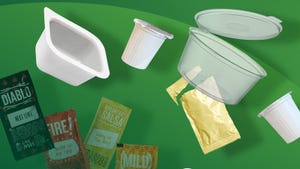New materials take the heat, and much more
February 1, 2008
|
With lightweighting and higher-temperature performance core requirements of the automotive and electronics industries, it is no surprise that suppliers are devoting significant resources to deliver materials meeting those needs.
One such development, unveiled at the K show in Düsseldorf, Germany last October, was an all-new polyamide from DSM Engineering Plastics (Sittard, The Netherlands). The material, PA4T, is said to offer a unique balance of properties, including excellent dimensional stability, compatibility with lead free soldering, high stiffness and mechanical strength at elevated temperatures, and excellent processability in terms of flow and processing window. “In automotive markets, we expect the material to support new developments in underhood applications relating to automotive electrical systems, air/fuel, and powertrain components,” says Roelof Westerbeek, global business director, Stanyl. DSM is currently constructing a market development plant in Sittard which will be operational in the first quarter 2008.
Also in polyamides, BASF (Ludwigshafen, Germany) debuted Ultramid High Speed PA 66 products with flow enhanced by up to 100% through the incorporation of nanoparticles. Incorporation of nanoparticles also improves heat-aging resistance at high temperatures, reports the supplier. The new materials are targeted for large components in the engine compartment such as cylinder-head covers or intercooler end caps, where they open up possibilities for lightweighting and/or easier processing through the use of fewer injection points.
Rhodia (St-Fons, France) was another to unveil a new development in polyamides with its Technyl Heat Performance (HP) range, boasting superior retention of properties, specifically when exposed to continuous high temperature. According to the supplier, this innovation broadens the field of polyamide usage to higher-heat environments where previously only PPA (polyphthalamide) could offer an answer. Rising underhood temperatures—on account of pedestrian impact requirements reducing the space available for the engine, among other factors—are precluding the utilization of PA 6 and even, in some cases, standard PA 66 in the engine bay. Technyl HP, however, retains its properties well, even with extended usage at 200°C. “After 2000 hours at 200°C, Technyl HP tensile strength falls by only 12% compared to 57% for conventional PA,” says Valérie Stoeckel, Rhodia’s application development manager for automotive. Technyl HP grades are available with glass fiber loadings of 35% and 50%.
Diversification and divestment
Radici (Chignolo d’Isola, Italy), meanwhile, is diversifying into polyamide 6,10 and 6,12, as well as amorphous polyamides. The new resins will be produced using a batch facility coming onstream next year at the company’s Novara, Italy site with capacity of 8000 tonnes/yr. “These new materials offer hydrolysis resistance and stiffness without the requirement for post-process conditioning,” says Giovanni Pioltini, marketing and technical service director. “Amorphous polyamide also exhibits good solvent resistance.”
K2007 marked the official launch of a “new” global player in the engineering thermoplastics plastics arena in the form of Sabic Innovative Plastics (Riyadh, Saudi Arabia), which was formed through Sabic’s takeover of GE Plastics, and it’s business as usual according to management. Since K, Sabic IP has divested its stake in a European PBT joint venture with BASF and announced the sale of its Azdel thermoplastic composite joint venture with PPG Industries (Pittsburgh, PA) to Korea’s Hanhwa Living & Creation (Seoul).
Ticona (Kelsterbach, Germany) is also working to provide lightweighting solutions to the auto sector through its Celstran long-fiber-reinforced compounds. Carsten Wörner, European sales director, says recent applications include a door module in which a high-gloss Celstran surface is exposed. “Surface quality is excellent even with 25–30% fiber loading,” he notes.
New Celstran continuous-fiber-reinforced tape products based on a variety of resins, including PP, polyamide, PEEK and PPS, can also bring weight reductions through materials replacement, according to Ticona. They can be processed via press consolidation, the Quickstep vacuum forming process, or automated tape lay-up, as well as incorporated into injection, extrusion, and compression molding processes.
COPE plays as PC killer
At K, Eastman Chemical (Kingsport, TN) introduced Tritan, a new copolyester. Key performance benefits of the new material include a higher heat resistance than traditional copolyesters, better toughness, and lower inmold stresses, without giving up any of copolyester’s noted chemical resistance. Together, these improvements will enable Tritan to outperform polycarbonate (PC) in appliance and housewares applications, according to Deborah Baum Crain, director of copolyester innovation for Eastman Specialty Plastics. “The housewares and appliance segment drove the development of this new material. Most dishwasher-safe parts are currently molded from either SAN [styrene acrylonitrile] or PC. SAN is brittle, while PC parts develop crazing after repeated exposure to hot water. Raising the heat resistance of the copolyester, which has much better hydrolytic stability, solves both problems. It has been tested at 500 commercial dishwasher cycles with no crazing.” Tritan’s heat resistance reaches 226°F, roughly 65°F higher than traditional copolyester materials.
You May Also Like





